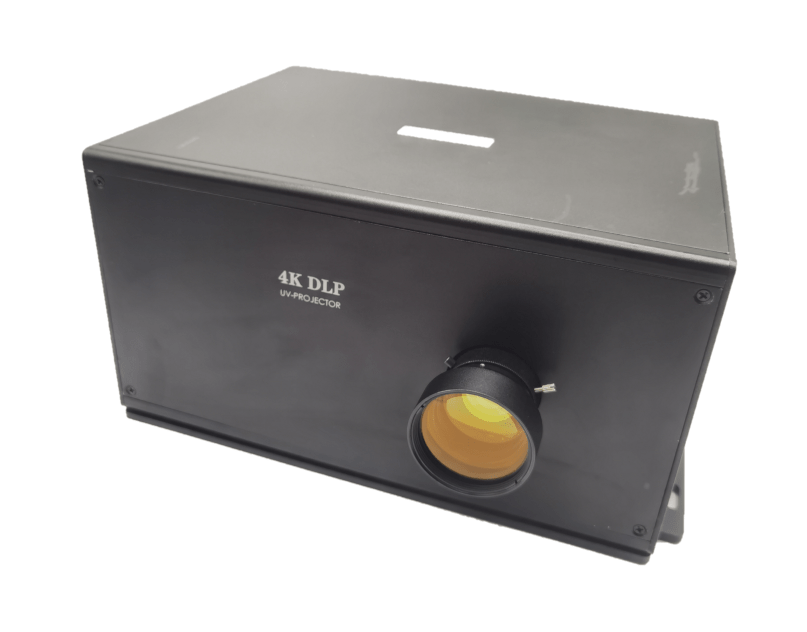Now the popular resin 3D printing technology on the market is mainly divided into SLA, DLP and LCD. This article will mainly explain the difference between DLP and LCD. DLP digital optical processing technology projects the light by digitally processing the image signal. LCD liquid crystal display technology uses the photoelectric effect of liquid crystal to generate images with different gray levels and colors.

- DLP light curing technology
1. Working principle
DLP is the abbreviation of "Digital Light Procession", that is, digital light processing. That is to say, the image signal is projected into light after digital processing. It is based on the digital micromirror element developed by Texas Instruments, DMD, to complete the visual digital information display technology. The basic principle of DLP3D printing technology is that the digital light source performs layer-by-layer projection on the surface of the liquid photosensitive resin in the form of surface light, and the layers are cured and formed.
A DLP projector creates an image of a layer by shining light through a lens into a DMD, an assembly of thousands of micromirrors, which must then direct the light to the bottom of the resin tank. Therefore, light from a DLP projector must expand from a small light source to cover a large area. Essentially, this means that wider models are more likely to have pixel distortions around their edges. Also, the number of pixels on a DLP projector is the same regardless of the print size. This means that smaller and narrower prints can be made with greater precision than wider prints done on the same DLP printer. To visualize this effect, consider a photo you take on a smartphone. When you zoom in on a photo, the sharpness decreases. This is what happens when large objects are printed on a DLP printer - they "shrink". That said, it's important to keep in mind that distortion corrections can be done on more professional gear with better quality components. Also, the "shrinking" issue doesn't necessarily mean that the DLP printer is a poorer print, just that its resolution is more focused on smaller prints.
The DLP light source mentioned here is a customized version of the Texas Instruments optical machine, which mainly removes the optical path coating, replaces it with UV LED lamp beads, readjusts the optical path, and so on. Its characteristics are longer life, low power consumption, generally only a few watts, and the light source utilization rate reaches more than 95%. Specially customized optical components have uniform light intensity and low distortion. The motherboards developed by some manufacturers can control the output light intensity of the LEDs, so that the printing accuracy and speed can be flexibly controlled, and the materials can be selected, which can be adapted to various consumables on the market. The size is small, so the machine can be made very small.
- LCD (Selective Area Light Curing Technology)
LCD is an emerging technology in 3D printing technology. It has become popular in recent years. The cost is greatly reduced and the entry threshold is within reach. The precision is comparable to DLP. It uses ultraviolet irradiation to cure resin as a molding method. The working principle of the LCD 3D printer is to use the LCD imaging principle of the liquid crystal screen. Driven by the computer and the display circuit, the computer program provides the image signal, and a selective transparent area appears on the liquid crystal screen. The ultraviolet light passes through the transparent area and irradiates the resin. The photosensitive resin consumables in the tank are exposed and cured. When the curing time of each layer is over, the platform pallet lifts the cured part to allow the resin liquid to replenish and reflow. The platform descends again, and the thin layer between the model and the release film is exposed to ultraviolet light again. As a result, it is cured layer by layer and printed into a beautiful three-dimensional model. Therefore, the LCD 3D printer imaged by this principle is also called "LCD 3D Printer.

It also flashes a full layer on the resin tank, but the UV light comes through the LCD instead of the projector's LED array. The screen acts as a mask, showing only the pixels needed for the current layer. In this way, special equipment like SLA and DLP is not required to guide light.
LCD 3D printers use a series of UV LCDs as light sources. The light from the flat-panel LCD panel strikes the build area directly in a parallel fashion. Since this light does not expand, pixel distortion is no longer an issue in LCD printing.
This means that the print quality of an LCD printer depends on its LCD density. The more pixels, the better the print quality. The resolution accuracy can be 0.05mm, and the format can be very large. And the cost is low, the core accessories are an LCD screen, motherboard, and Z-axis track.
Since the LCD screen itself is afraid of ultraviolet rays, it will age rapidly after being irradiated. This technology itself requires high-power ultraviolet light irradiation, and uses a very small amount of ultraviolet light to cure, so its life is relatively short compared to DLP. When purchasing, it mainly depends on the size, resolution, and Z-axis stability, and the most important thing to consider is whether it is convenient to disassemble and replace.
In terms of price, because the hardware cost of DLP is inherently high, the price is often 10 times that of LCD. If you are a professional who needs high detail and fast printing speed, it is recommended that you consider using a professional DLP printer. On the other hand, if you are a beginner in resin 3D printing, LCD would be a good choice.


Share:
Property Rights of UV Projectors -SICUBE
Transparent version power bank? This is the Sharge 130W visual power bank